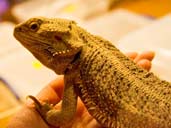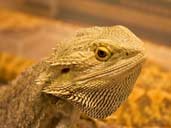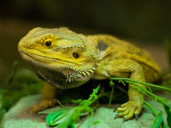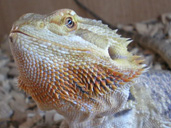Bearded Dragon Care Sheet
Common names: Bearded Dragon, Inland Bearded Dragon or Central Bearded Dragon. Scientific Name: Pogona vitticeps (There are actually eight species of Bearded Dragon in the Pogona Genus, but Pogona vitticeps is the one that is common within the pet trade and is usually the species that most people associate with the name ‘bearded dragon’). DescriptionDescription: Bearded Dragons are a heavy-bodied, yet relatively small species of Amagid lizard, which upon maturity has a noticeable ‘beard’ in the form of spikey scales protruding from the throat that the dragon makes prominent when angry or excited. They are generally tan, beige or grey in colour, but captive breeding as created a substantial range of morphs available within the pet trade. Size: Bearded Dragons generally grow to between 40 to 60 cms (16-24 inches) in length. Life span: Bearded Dragons can live up to 7 – 10 years with appropriate care. Origin: Bearded Dragons are native to Australia. Habitat: Bearded Dragons are generally a terrestrial species, so spend the majority of their life on the ground, but are also partly arboreal so occasionally venture into the trees. Their natural habitat includes arid and semi-arid desert and bushlands, which are both dry and sandy. They are a heat-tolerant species and can often be seen in elevated, rocky positions basking in the sun. Temperament: Bearded Dragons are highly inquisitive and lively lizards, who are diurnal so active by day. They make an ideal first lizard as they are relatively easy to care for and they can become quite tame with regular interactions with their keeper. They are a communal species, so they can be kept in groups, but males that are housed together may fight, so it is best to keep just one male with a female or multiple females. Keeping bearded dragons in a group would mean that you would need a larger vivarium and plenty of hides to ensure that all your bearded dragons have room to move around and have many places to feel safe. When bearded dragons feel threatened they will inflate their beards to warn off predators. This along with the head bobbing gesture, that is common during mating and territorial displays, make them an interesting species to observe. Things to consider before purchasing a Bearded Dragon
HousingAdult Bearded Dragons are quite lively and appreciate a large vivarium. A 3ft vivarium or a 40 gallon tank should be adequate for a adult bearded dragon, but the more space you can give them the better, especially when housing multiple bearded dragons together. Bearded Dragons do well in a dry savannah (woodland) or desert type set-up. Your vivarium should containSubstrateThere are various substrates that can be used for bearded dragons including sand and bark chips, but a simpler, but less attractive substrate is paper towels or newspaper. These are cheap, fit for purpose and easy to clean if they become soiled. Somewhere for your Bearded Dragon to hide.All Lizards require somewhere to hide and may become stressed if this is not provided. This could be a commercially made lizard hide from a specialist reptile shop or simply a plant pot on its side, which is low cost but easily cleaned. If you are keeping multiple Bearded Dragons in a vivarium then it is important to provide a hide for each of the bearded dragons housed. Logs, stones and cork bark make good natural looking additions to your vivarium and make great hiding places. Live succulent plants and cacti can also be used, but be aware that some live plants may be harmful to your bearded dragon, so researching reptile safe varieties is very important when using live plants. Any Stones or branches that are collected from the wild need to be debugged by soaking first in chlorine & water solution, rinsed thoroughly and soaked again in clean water, then left to dry in the sun before placing in your bearded dragon’s vivarium. A change of sceneryBearded Dragons are very inquisitive animals and like to explore new surroundings. Once in a while change the layout of the vivarium and this will keep your Bearded Dragon from becoming bored. You will notice once you put your Bearded Dragon back in the tank it will start to re-explore its new surroundings. WaterAll Lizards, including Bearded Dragons need fresh water daily. A large water bowl (big enough for your bearded dragon to bathe in) should be placed within the vivarium, which is changed frequently to avoid the build up of bacteria. Humidity Bearded Dragons do not require high humidity, but a little more than normal room humidity should be maintained during the shedding process. Misting the tank occasionally with water in a spray bottle should keep the humidity around the right level. Good ventilation is essential in a bearded dragon’s vivarium to ensure that humidity levels do not become too high. Heat and lightingThere are a variety of different ways in which to provide sufficient heat and light within the vivarium, but it is important to note that regardless of the type of equipment setup you choose, Bearded Dragons require a basking spot with temperatures around 40°C (104°F), with surrounding temperatures around 28°C (82°F) and 12 hours of full spectrum UVA/UVB lighting. They are a diurnal species, so light is not required at night time, and temperatures can also be allowed to drop overnight to simulate the conditions they would be accustomed to in the wild. The right sort of lighting is critical for the health and well-being of your Bearded Dragon, as they require UV-B lighting to help their bodies absorb vitamin D3. When choosing appropriate equipment for your bearded dragon’s enclosure, you must decide whether you are going to provide heat and UVB lighting in one unit or if you are going to run separate devices for creating the required heat and light. All equipment should be readily available from reptile specialist and online suppliers. Basking lights are appreciated by bearded dragons, who like to bask under a hot heat source during the daytime. A suitable heat emitting bulb can be attached to the roof of the vivarium using a porcelain heat-resistant socket and is quite safe as long as a guard if fitted to ensure your bearded dragon cannot come into contact with it. Some of these bulbs can provide both sufficient heat and light, so it is important to understand the capabilities of the bulb before using within the vivarium. Additional UVA/UVB lighting may not be required if the bulb you have chosen provides this full-spectrum light. The disadvantages of using these type of bulbs is that they have a relatively short shelf life, so need to be replaced regularly (approximately every 6 months to a year dependant on type of bulb). Using a bulb also means that to provide heat there must always be light. Bearded Dragons only require a 12 hour photoperiod per day, so it is beneficial to allow them some hours of darkness at night. This may mean that a secondary heat source may be required specifically to provide warmth during the night, particularly during the winter months or if your house is predominantly cold. Another option is to provide heat using a ceramic heat bulb that produces no light, but keeps the ambient air temperature high. This would require you to provide additional UVB lighting during the day to allow your bearded dragon to bask. Florescent lights are a good source of UVB lighting to use with a separate heat source like a ceramic, because they do not emit too much heat, so should not affect the temperature controls within the enclosure. All heat sources need to be controlled by a suitable thermostat and be protected by a guard. Heat bulbs usually work well on Dimmer stats, whilst Ceramic heaters require a Pulse Proportional stat. Some thermostats can be purchased that will automatically lower the temperature at night time, but these are usually a little more expensive to buy. On/off timers can also be purchased to control the hours of light, but this is a convenience device and not necessary for the safety of your Bearded dragon. Natural sunlight can be beneficial to your bearded dragon, so 10-20 minutes outside on a summer’s day may be appreciated. It is important to ensure that your bearded dragon cannot escape for become too cold in these instances though. General Care
|
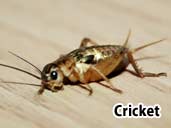 |
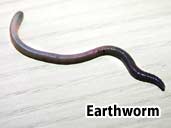 |
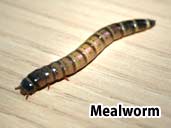 |
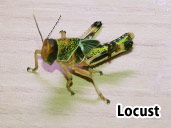 |
Bearded Dragons are omnivorous and should be fed 4-5 times a week with a varied diet of both appropriately sized gut-loaded insects and fresh, chopped vegetables and fruit. A recommended ratio of insects to fruit to make up the diet should be around 80% insects to 20% vegetables, fruit or flowers.
Feeder insects including mealworms, crickets, small grass hoppers, earthworms, waxworms, spiders and roaches can be fed to your bearded dragon, but these should be dusted with a good D3 and calcium supplement regularly. This is especially important as they grow from juvenile to adult as growing bearded dragons require more calcium in their diet to aid healthy development. It is advised to give hatchling bearded dragons additional supplements with food on a daily basis, while adult bearded dragons may only need their food dusting every 3-5 days. Cuttlefish may also be given to boost your bearded dragon’s calcium intake.
Suitable chopped vegetables and fruit include dandelion leaves, cabbage, turnip greens, nasturtiums, squash, broccoli, apples, clover, green beans, carrots, melon, grapes, peaches and bananas (with skin). All should be washed before being given to your bearded dragon and obtained from a guaranteed pesticide/chemical free source. Alternatively, frozen and thawed mixed vegetables can also be used, but avoid iceberg lettuce as this as no nutritional value. Feeding too much high green cabbage is also not good for your bearded dragon as it can interfere with the absorption of calcium, but keeping the food offered as varied as possible will usually avoid this type of problem occurring. Remove any uneaten organic matter daily to avoid your bearded dragon eating rotten/moudly food and to prevent bacteria building up within the vivarium.
Many reptile stockists may also have a prepared diet available to buy that is balanced specifically for bearded dragons. These are usually purchased in the form of dried pellets or in sealed cans. They offer your bearded dragon a complete diet, so the addition of extra nutritional supplements should not be required, although many bearded dragons may not take commercial food without disguising it amongst chopped greens or by hand feeding. This is because some bearded dragons are more attracted to the movement of live food, so do not readily recognise the prepared pellets as food. Commercially prepared foods are a good food source to use regularly, but it is not recommend to feed your bearded dragon on them solely, but to use them only as part of a varied diet.
As an adult your bearded dragon should be able to feed on the occasional pinkie mouse, but you should regard this as a treat item as regular feedings on mice can cause your bearded dragon to become obese.
Cleaning
Your bearded dragon’s vivarium should be inspected and spot cleaned daily when changing the water.
Every two to three weeks clean out the tank completely and sterilize the vivarium using a reptile friendly disinfectant. You will also need to remove and sterilise any décor, ready to replace back in the vivarium when it has been cleaned. Your bearded dragon(s) should be moved to a temporary tank during the cleaning process.
Shedding/Sloughing
Bearded Dragons shed their skin at regular intervals as they grow. The old skin is pushed off is normally eaten by the bearded dragon. Your Bearded Dragon should go through this process every 3-6 weeks, dependant on its rate of growth. Prior to sloughing your bearded dragon’s skin may take on a dull or milky appearance.
Most Bearded Dragons will handle a shed without any need for extra help, but if you want to assist your bearded dragon during this time you should try to raise the humidity in your vivarium to help it loosen it's skin. You can do this by placing a larger water bowl in the vivarium so that your bearded dragon has the opportunity to soak itself if desired. You can also lightly mist the tank with water to help raise the humidity. Another useful tactic is to place a humidity box in the vivarium. This can be a sandwich box with a hole cut in the top filled with damp sphagnum moss. Your Bearded Dragon should appreciate the extra humidity and it will make the shedding process easier. Additionally, placing a rough surface within the vivarium to assist your bearded dragon during the actual shedding is also recommended. Rocks, stones and branches can all be used for this purpose.
After your Bearded Dragon has shed its skin, you should make sure that all traces of the old skin have completely come away from your bearded dragon’s body. This is particularly important around awkward areas like toes and the tip of the tail. If not, you may need to assist your bearded dragon by removing any retained shed by either gently rubbing your bearded dragon with a towel after a soak in warm water or by working the skin away with a cotton bud. Retained skin can interfere with the blood supply on a part of your bearded dragons body if it is not removed, so it is important to be aware of this to avoid your bearded dragon losing a limb or becoming deformed.
Handling
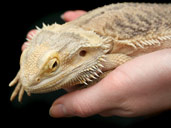 Bearded Dragons seem to appreciate being handled, but care should be taken to ensure that they are held gently, but tightly to avoid any incidents if the bearded dragon wriggles free. The main concerns include dropping your bearded dragon from height, losing your bearded dragon or accidently injuring your bearded dragon through mishandling. All these incidents can be avoided by adequately supporting your bearded dragon, only handling in a safe area and supervising children whilst handling. Always support the body of your bearded dragon and never grab or pull on any parts of its body including the limbs and tail. Handle confidently so as not to scare your bearded dragon, who may interpret your anxiety as a threat and may then struggle to get away. With these procedures in place handling can become an enjoyable experience for both you and your bearded dragon who will appreciate the exercise and may become more responsive to its owner.
Bearded Dragons seem to appreciate being handled, but care should be taken to ensure that they are held gently, but tightly to avoid any incidents if the bearded dragon wriggles free. The main concerns include dropping your bearded dragon from height, losing your bearded dragon or accidently injuring your bearded dragon through mishandling. All these incidents can be avoided by adequately supporting your bearded dragon, only handling in a safe area and supervising children whilst handling. Always support the body of your bearded dragon and never grab or pull on any parts of its body including the limbs and tail. Handle confidently so as not to scare your bearded dragon, who may interpret your anxiety as a threat and may then struggle to get away. With these procedures in place handling can become an enjoyable experience for both you and your bearded dragon who will appreciate the exercise and may become more responsive to its owner.
It is advisable to wash your hands both before and after handling your bearded dragon with a good anti-bacterial hand wash or sterilizing hand gel. This is basic good hygiene that will not only safeguard you and your family, but will also promote the health of your bearded dragon too.
Sexing
Sexing your bearded dragons can be quite straightforward, although some gender behaviors that are usually used to determine sex may not be completely accurate as females may also occasionally display these characteristics. Generally though you can usually spot a male by looking for the darkened black throat that the males often develop during the breeding season or in times when they are trying to assert their dominance. Males can also be more aggressive during the breeding season and tend to be more outgoing in general as females tend to be more submissive. Males have a broader head and wider tail base, but this may not become apparent until they mature, so is not useful for determining the sex of hatchlings.
Another way of determining sex is holding your bearded dragon and gently raising it’s tail to look at the underside and noting the bulges above the vent (cloacal opening). If there are two noticeable bulges at either side just above the vent then this bearded dragon is probably a male. These bulges are where the male’s two hemipenes are housed. If there is only one or no noticeable bulge above the vent then this would indicate that your bearded dragon is either female or too young/small to sex. Only bearded dragons over approximately 15cm can be accurately sexed this way.
Some keepers may recommend probing as a good way to determine the sex of your bearded dragon, but it is not advisable to use this method as your bearded dragon could be injured during the procedure. If you do decide to probe your bearded dragon then please ensure that it is performed by a qualified and experienced reptile specialist or vet.
Breeding
The breeding season for Bearded Dragons is generally the spring and summer months, after about a 2 month conditioning period (brumation) in the winter where light, temperature and food have been reduced. Start this by reducing food first, then begin to slowly lower the hours of daylight to around 10 hours and the temperatures to around 29°C (80°F) during the day and 18°C (65°F) at night time. Fresh water should still be available at this time. Light, heat and feeding should be gradually re-introduced upon completion of the conditioning period and breeding behavior should begin a few weeks of these factors becoming normal again.
Bearded Dragons are oviparous (egg bearing) and, although they may reach sexual maturity earlier than this, they do not reach a good breeding age until they are at least 18 months old. They should also be a good health and weight before they are allowed to breed. This is important because breeding underweight or unhealthy bearded dragons not only puts your adults at risk as they are more susceptible to breeding complications, but it would also greatly reduce your chances of producing viable offspring. To help your female maintain a healthy weight they should be fed up prior to breeding to ensure they have enough condition to be successful egg producers.
Females that are housed with a male should lay several clutches per year, but if you house your bearded dragons separately then the female can be introduced to the male’s vivarium, which gives you more control over the frequency of the clutches. This will also benefit your female who may need a resting period after laying each clutch to regain her energy and weight without interference from the male. Each clutch should have approximately 10 - 20 eggs, which the female will lay in deep soil or vermiculite, which should be provided in the form of a deep nesting box or burrow. A large plastic tub or tray with an entrance hole cut into the lid is suitable for this purpose, as your female would appreciate not being disturbed at this time.
Once the eggs have been laid they should be removed and incubated half buried in vermiculite at approximately 29°C (84°F). The incubation period is generally around 60 days.
Once the eggs have hatched the hatchlings can be kept together, but must be monitored for signs of aggression as they order their own hierarchy. If you are worried about any of the hatchlings then you should separate as necessary.
Hatchlings should be fed twice daily, with a good calcium and vitamin supplement dusted on at least one of these feeds. Food items should be no wider than the size of the hatchlings mouth, so ensure that all food offered is an appropriate size. Growing bearded dragons can consume a great amount of live food, so this should be considered before breeding your bearded dragons. The cost of rearing hatchlings can be substantial in comparison to the profit you would make from selling them on, so it is advisable to have guaranteed homes waiting for the hatchlings before commencing on a breeding cycle.
Any other questions?
This care sheet is a simple step-by-step guide to successful Bearded Dragon keeping, but if you have anymore questions or need more specific information about the keeping of Bearded Dragons, please enter our forum. It is a useful resource where you can ask members to share good practice and also talk about your experiences of being a Bearded Dragon keeper.

